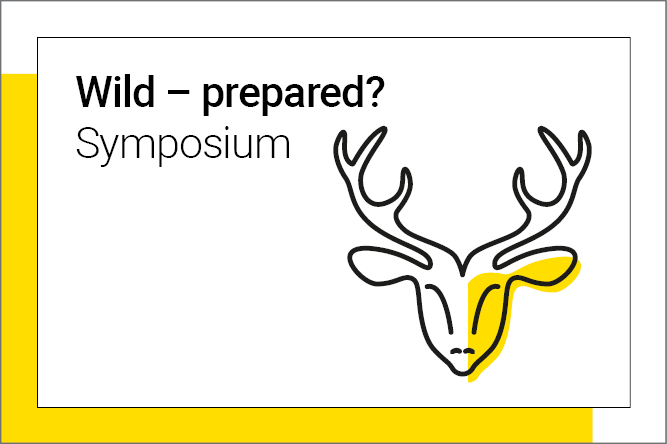14.03.2024: BfR-Symposium: Wild – prepared?

BfR-Symposium: Wild – prepared?
The German Federal Institute for Risk Assessment (BfR) has conducted scientific research on the broad topic of game meat food safety for 12 years.
The presentations can be found further down this website.
-
Details
The aim is to minimise metallic fragments in game meat from food-supplying game species obtained by hunting, which can pose health risks, especially for hunters and their families who are frequent consumers. Proof of minimising the introduction of metallic fragments from leaded and lead-free rifle bullets can only be provided through knowledge and standardised procedures.
The BfR raised the question of whether lead particles in game meat can increase the lead content of food after cooking at the "Wild - Well shot?" conference. The results of the investigation, which used pigs as a model animal in a feeding trial, will be presented. What is the impact of hygiene measures on game meat after shooting? This question was also investigated in a BfR dissertation, and the results are reported here.
How can metallic fragments be detected by weight, size and distribution in game meat (roe deer)? How are they distributed and how can they be detected? The detection of fragments also includes the question of how the various hunting bullets behave when fired. When using leaded or so-called lead-free bullets, various metals are used as bullet materials to convert the kinetic energy of the bullet into killing work. To ensure equal conditions for bullet testing and evaluation, a standardised firing procedure is necessary. Developing a standardised test and evaluation procedure for hunting rifle bullets required breaking new ground. To ensure objectivity, the test procedure should clearly describe the individual work steps, test criteria, and environmental conditions. These requirements indicate that additional investigations have to be conducted to compare two commonly used gelatin block sizes when firing different high-energy hunting bullets. The results showed that only the large block size is suitable as a test simulant for high-energy bullets. Further results indicate that additional investigations into the use of large gelatin blocks are necessary. It was also important to clarify the effects of different mold materials, the duration of the cooling phase, and the influence of different storage periods before firing on the test results. The results obtained from these investigations now allow the use of the internationally recognised test simulants such as gelatin and ballistic soap. Standardised test procedures and standardised evaluation procedures now enable reproducible results.
The BfR, together with an international panel of scientific experts, has summarised the results of the scientific investigations in a product profile for testing hunting bullets for food-supplying game species. These contains terms to be used in the test with information on the bullet, a physical fact sheet and a chemical fact sheet on the test procedure. The panel also adopted definitions and terminology to ensure uniform understanding.
To make the standardised test and evaluation procedure for proof tests of hunting bullets internationally usable, the BfR plans to conduct a round robin test with international participation in 2024.
In addition to scientific research, international exchange with experts is an important aspect. With the approval of the COST Action "Safety in the Game Meat Chain" (CA22166; duration 2023–2027), the BfR and the participating project partners are contributing to the establishment of a Europe-wide network of experts. The focus is on exchanging knowledge on health risks to consumers from game meat obtained from hunting along the entire product chain.
Two informative days await you at the German Federal Institute for Risk Assessment!
Presentations from 14.03.2024
PD Dr. Robert Pieper, BfR, Berlin
Food safety of game meat obtained from hunting
Dr. Ulrike Pabel, BfR, Berlin
Health risks of lead, copper, zinc in game meat
Dr. Anneluise Mader, BfR, Berlin
The SafeGameMeat network (COST Action 22166)
Dr. Eva Trojnar, BfR, Berlin
Rotaviruses and hepatitis E viruses in wild boar and wild ruminants in Brandenburg, 2019-2022Annina Haase, BfR, Berlin
Analysis of bullet fragments in roe deer carcasses
Dr. Kirsten Schulz, BfR, Berlin
Bioavailability of lead – influence of culinary preparation
Dr. Niels Kanstrup, Aarhus Universität, Dänemark
Hunting rifle ammunition – a technical, sociological view on benefits, performance, availability and monitoring the success
Finn Schrader, Universität Göttingen
Review of the gelatin specifications of the manufacturer Gelita
Presentations from 15.03.2024Dr. Ellen Ulbig, Annett Martin, Ingo Rottenberger, BfR, Berlin
Suitability test of gelatin as a test simulant in two block sizes when fired with a very high-energy hunting bullet > 5000 J and test of a modified crack length measurement method
Annett Martin, Dr. Ellen Ulbig, Ingo Rottenberger, BfR, Berlin
Suitability of two gelatin block sizes as ballistic simulants for hunting rifle bullets with 2900 J
Ingo Rottenberger, Annett Martin, Dr. Ellen Ulbig, BfR, Berlin
Investigation of the influence of moulding materials, cooling phase and storage time on large gelatin blocks as a test simulant for hunting bullets
Ingo Rottenberger, BfR, Berlin
Standard operating procedure soap
Dr. Monika Lahrssen-Wiederholt, BMEL, Berlin
Results of the expert discussion “Methods of recording bullet fragments and measurement procedures for describing a reliable killing effect in simulants”
Ingo Rottenberger, BfR, Berlin
Concept of the round robin testVenue:
German Federal Institute for Risk Assessment (BfR)
lecture theater
Diedersdorfer Weg 1
12277 BerlinDirections
https://www.bfr-akademie.de/english/locations/marienfelde.html
Destination stop (www.bahn.com/en, www.bvg.de/en):
“Nahmitzer Damm/Marienfelder Allee (Berlin)” -

